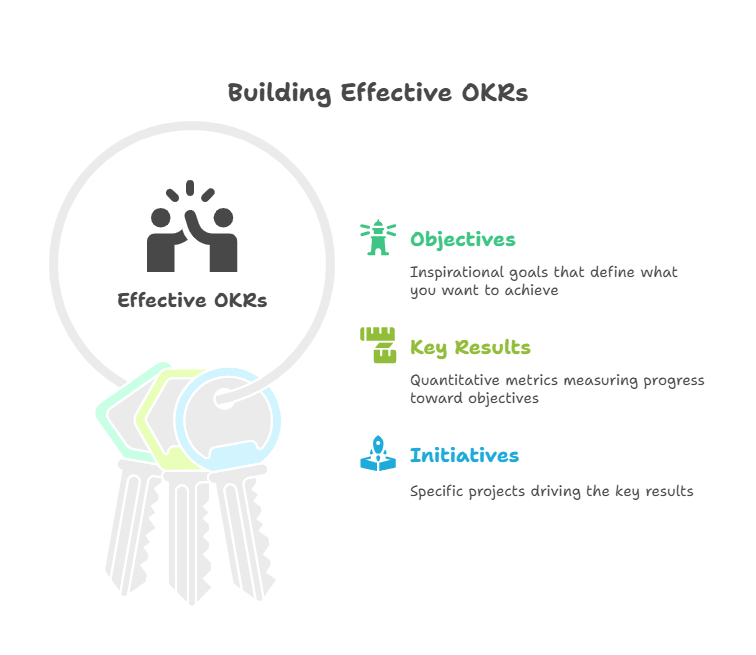How to Write Effective OKRs for Product Teams
Learn how to create powerful OKRs that align product teams, drive measurable outcomes, and connect product strategy to business objectives.
What Are OKRs and Why They Matter for Product Teams
OKRs are a goal-setting framework that Product Managers use to stay focused on what matters, measure results, and set clear expectations within the Product Team. Unlike traditional roadmaps that focus on outputs, OKRs help product teams concentrate on outcomes that drive business value.
The framework works particularly well for product teams because it's designed for cross-functional collaboration. As Product School explains, OKRs for product organizations are typically set by a cross-functional group that delivers product, sometimes referred to as the 'triad' or 'trio,' which includes Engineering, Product Management, and Product Design.
The OKR Framework Structure
OKR stands for Objectives and Key Results. According to Microsoft's Viva Goals documentation, objectives represent your conceptual goals, while key results are the specific numbers and metrics you need to reach to achieve those goals.
The basic OKR formula follows this pattern: "I will [OBJECTIVE] as measured by [KEY RESULTS] via [INITIATIVES]." This structure ensures that every ambitious goal is backed by measurable outcomes and concrete actions.
Components of Effective OKRs

- Objectives: Inspirational, qualitative goals that define what you want to achieve
- Key Results: Quantitative metrics that measure progress toward the objective
- Initiatives: Specific projects or actions that will drive the key results
How to Write Powerful Product OKRs
Writing effective OKRs requires balancing ambition with measurability. Your objectives should be aspirational yet achievable, while your key results must be specific and quantifiable.
Start with Strategic Alignment
Product OKRs should directly support company-level objectives. As Tim Herbig notes, product strategy and OKRs share a common attribute: they guide product teams to help make the right decisions to progress across the various levels of a company.
Focus on Outcomes, Not Outputs
Instead of measuring features shipped, effective product OKRs measure customer behavior changes and business impact. Product teams either need access to strong evidence about the required changes in behavior in their target audience or can use OKRs to structure and track explorative product discovery activities.
Common Pitfalls to Avoid
Many product teams struggle with OKR implementation. One critical mistake is tying OKRs to performance evaluations. Productboard warns that if OKRs are to be made sufficiently ambitious, they need to be kept separate from performance evaluations. Otherwise, goals tend to be set too conservatively.
Another common issue is creating feature-based roadmaps that conflict with outcome-oriented OKRs. As Herbig's guide explains, a feature-based roadmap is more of an obstacle than an enabler of outcome OKRs for product teams.
Practical OKR Examples for Product Teams
Looking for inspiration? Tability.io provides numerous OKR examples specifically tailored for product teams and product managers. These examples demonstrate how to connect product initiatives to measurable business outcomes.
Example: User Engagement Objective
- Objective: Create a more engaging user experience that drives daily active usage
- Key Results:
- Increase daily active users from 10,000 to 15,000
- Improve user session duration from 3 to 5 minutes
- Reduce bounce rate from 40% to 25%
Implementing the OKR Cycle
Successful OKR implementation follows a regular cycle. Tim Herbig outlines the OKR cycle for product teams, which typically includes quarterly planning, weekly check-ins, and end-of-quarter reflections. This rhythm ensures OKRs remain relevant and teams stay aligned throughout the quarter.
Visualizing Your OKRs with Mind Maps
Creating effective OKRs requires connecting multiple layers of objectives, key results, and initiatives. Using a visual framework like a mind map can help product teams see the relationships between company goals, product objectives, and team initiatives.
At ClipMind, we've found that visualizing OKRs as mind maps helps teams maintain strategic alignment while tracking progress toward measurable outcomes. Our AI Outline Maker can help structure your OKR planning process, while our Project Planner tool assists in breaking down initiatives into actionable steps.
Making OKRs Work for Your Team
The most effective OKR programs evolve over time. Start with a single product team, learn what works for your organization, and gradually expand the framework. Remember that OKRs are primarily a communication tool that helps align cross-functional teams around shared outcomes rather than a rigid performance measurement system.
By focusing on measurable outcomes, maintaining strategic alignment, and regularly reviewing progress, product teams can leverage OKRs to drive meaningful impact and deliver customer value that moves business metrics.
 ClipMind
ClipMind